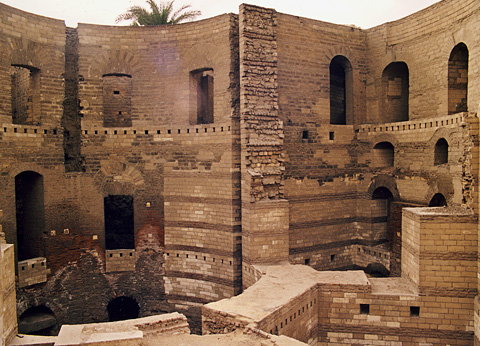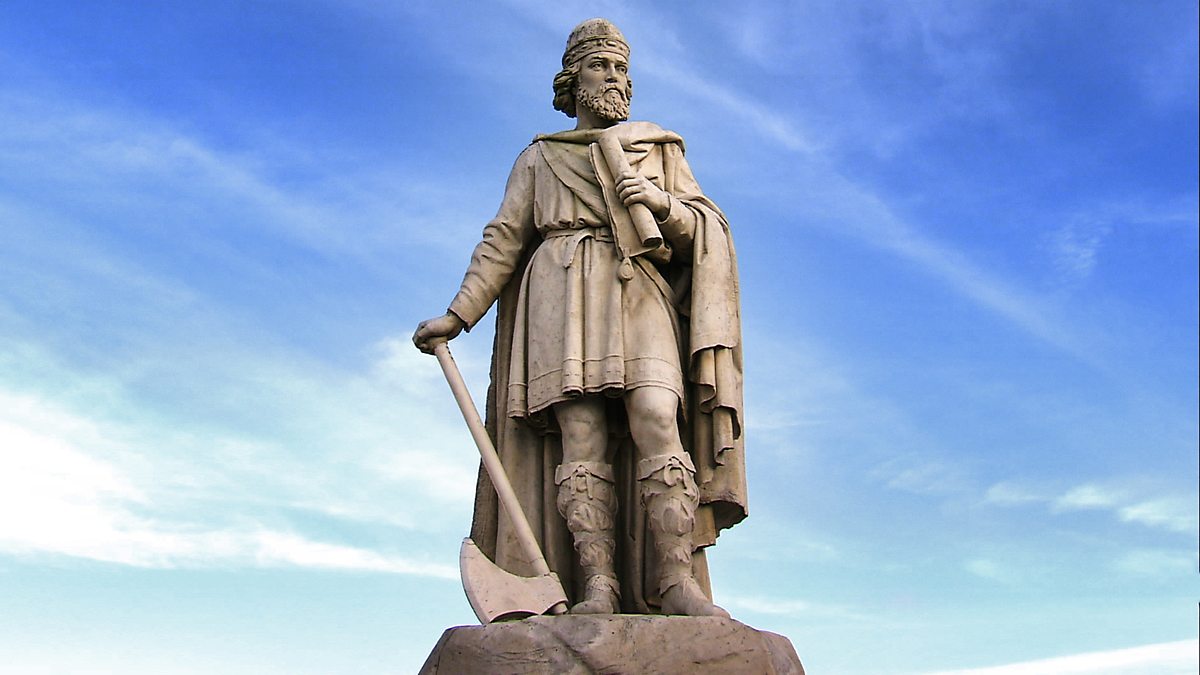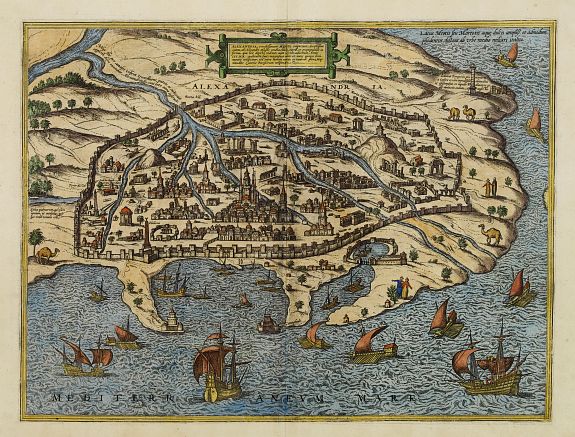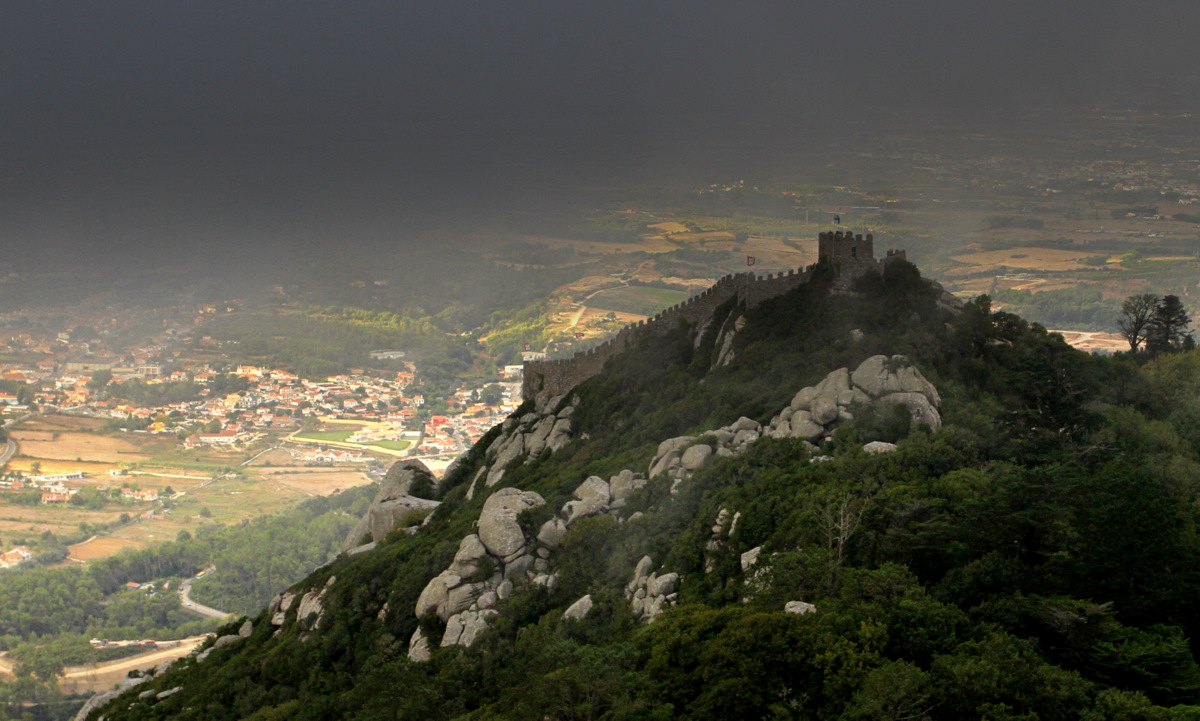9. The Dalmatian War
Thucydides' Trap:
The Greek Historian Thucydides described the Peloponnesian War as an inevitable consequence of Athen’s rise, writing that the dispute between Corcyra and Corinth was but the last of a series of flash points in the long lead up to the clash. For the Carantanians and the Grecians a similar reality existed.
The question of which one precisely the rising power was depends on the scope from which the question is examined. Certainly, in the exact context of the mid 800s, it was the Byzantines on the rise relative to the Carantanians. However, as the Grecian peak had arguably been under Justinian, and Carantania had only become a notable power a century earlier, it may also suffice to characterize the Grecians as the established power at risk of being usurped. Regardless, the tension between the two powers was apparent. In no less than three areas macro forces were pushing the two towards conflict.
The fierce naval and economic competition between Trst and Venice on occasion turned the Adriatic into a literal battleground. During the late 850s the two cities to intimidate and block each other gradually gave way to ships flagged to their cities assuming each other to be hostile and fleeing or attacking upon recognition. By the time of the Croatian crisis Trst was already on a war footing.
On the opposite end of the Balkans the Bulgars represented the next area of confrontation. The Bulgars had long been an annoyance to the Grecians. The Bulgars occasionally raided, with increasingly less success now that the Roman state was on the upswing again. That they also often involved themselves in Roman politics, supporting one side or another during internal crises, was a much more concerning matter. That Carantania was allied with them and bending over backwards to assist them in the steppe war could only be interpreted as an endorsement of such behavior. The Grecians must also have been aware of Ratislav’s policy of not moving an inch east of the Dnieper, effectively meaning that the war hosts the Carantanians and Bulgars had raised to fight the Khazars could be repositioned to fight in the south.
The final area of contention lay between the other two, and fittingly would explode outwards to engulf those regions as well. Croatia was an area of interest to both polities. To Levan quote Levan the Kartvelian’s On The Carantanians, Croatia was, “The half-civilized fringe region between the vibrant economies of the Mediterranean coast and the tribal despotism of the interior.” Both sides had jockeyed for influence over the Duchy, a contest which Carantania had been winning. Basil I sought to change this and threw his support behind the usurper Domagoj of Croatia, who had deposed Duke Zdeslav of the long reigning Trpimirović dynasty in 864. Zdeslav and his brothers were quick to make a beeline for their aunt’s residence in Ljubljana,[1] wherein they became a fixture of Queen Ema’s court. Domagoi’s call for independence from Carantanian pretensions was eagerly embraced by the Dalmatians, who were eager to be able to fight back against the impositions of Trst. In the interior however, the deposition of the prestigious Trpimirović dynasty was less well received. The result was a civil war in which Duke Domagoj received direct military assistance from the Grecians.
Beyond these macro influences, there were individual actors as well which ensured that Carantania and the Grecians would come to blows.
Carantanians were on the frontlines from day one. Many of the Pannonian Slavic nobles had freely intermarried with the Croatian nobility, and accordingly had family or even held title in the Duchy. With Carantanian nobles and levies already deployed on the side of the legitimists, formal Carantanian entry was inevitable.
There were also some who openly sought war. Queen Ema repeatedly wrote to her husband and other major nobles to make war with the usuper as she found Zdeslav’s case compelling, and war was supported by both supporters of the king and nativists who disliked having a Moravian monarch.[2] The militia of Trst was also gnawing at the bit for a chance to settle the score with Venice, and went ahead without royal direction. In a largely unprovoked coup de main, the Trst militia struck two targets at once in an effort which demonstrated an unrivaled mastery of amphibious and littoral combat. The westward prong was comprised of a trio of merchant ships which sailed into Venice to trade, their cargo hulls packed with militiamen who quickly commandeered the most warlike of the Venetian ships moored there, and burned those which they could not crew. For the remainder of the war Venice would be blockaded by its own navy. At the same time the bulk of the militia attacked and seized the islands of Cres and Krk from their Roman garrisons.
Basil I scored an even more impressive victory when he determined that the end of the Steppe war a month prior could only have meant a preparation for war. Determined to not be caught off guard he redirected the troops of the Armenian themata destined for Croatia to instead first check the sharpness of their swords on the Bulgars. In the decisive Battle of the Maritsa the massive army raised and lead by the Bulgar Khan imitated Carantanian tactics and anchored it’s right flank on the river. However the veteran troops of the Armenian Theme proved to be a wholly different opponent from the Khazars, and the Bulgar right flanks was flattened by a timely cataphract charge. The survivors of this action were driven into the river, bringing about the near extermination of the Bulgar nobility.
With the activation of the Carantania-Bulgar Alliance, a formal state of war at last existed between the two great powers.
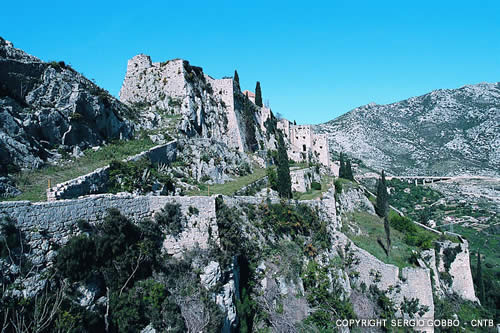
The impenetrable fortress of Klis, with walls built right to the edge of shear cliffs, served as Domagoj's capital
The Conclusion of the Steppe War:
By March of 864 the Ratislav’s policies hadn’t done anything more than entrench the existing stalemate. The conflict had long run its course, seeking to avoid calling their troops up for yet another campaign season the combatant sides opted to instead cut their losses then and there. In the treaty the Bulgars agreed to a border on the Southern Buh.
Seemingly, the Khazars won. However even more so than the Bulgars they were spent. Little more than an appendix of the Magyar horde, something Levan described in his final writings as, “The rightful place of the Hebrews.”[3] The Khazar decline accelerated further when the Varangians who had made their way south in preparation for their spring employment found themselves neither needed nor wanted. A set of circumstances which lead to them seizing the Dnieper basin in Rurik’s name.

Varangian rule in Kyiv
The impairment of the Arabs:
A final question that needs to be addressed before going any further into the Dalmatian War is the matter of why the Grecians felt secure campaigning west with their eastern forces. The answer to that is straight forward. The Ummah was imploding.
The Mihna refers to the Abbasid policy of persecuting non-Muʿtazila sects of Islam. As Magyar raiding began to subside in the 840s the Abbasids needed to find new ways keeps their hosts of Turkic slave soldiers preoccupied. Thus, the implementation of the Mihna in the countryside fell to them, and the persecution which might have been a mere phase became an institution vital to the function of the Abbasid state.
With academic efforts to end the policy failing, many non-conformists sought to escape the reach of the Abbasids. Ahmad ibn Hanbal had sought to do so in such a way which would not endanger the unity of the Ummah and arranged for his “kidnapping” by Magyars. However, much like the attempt to steal the corpse of Ali, this plan was found out and he was executed for spreading fitna. Following this his followers and many other non-conformists took up a sort of mimicry Hegira, residing in any community willing to shelter them.
The tyranny of the Mihna did not go un answered. It began first as an insurgent campaign spear headed by the Kharijites, but by the 860s it had evolved into pitched battles waged by vast armies. As the revolt was being put down a second one, comprised of Zanj slaves, erupted in lower Mesopotamia. The Abbasids would only survive by yielding authority to those serving them in the field, entrenching the Mamluks as the true power within the Caliphate. In time the slave soldiers and slave bureaucrats would cloister the Caliph within the earthly paradise of Baghdad, where he would be kept ignorant of their affairs and conduct beyond the city’s ring-like walls. The Mihna had not only brought about the one thing it was meant to stop,[4] but it had brought the whole Islamic golden age crashing down.[5]

A selection of turkish swords
[1] You may recall that would-be-King Semik had married the sister of Duke Trpimir. She’s not the queen obviously, but she has been permitted to reside in Ljubljana all the same.
[2] Ironically the nativist faction coalesced around the Croat princess in opposition to Carantanian queen.
[3] And unless one of you wants to invoke that judgmental twat in a guest post, that’ll be the last we hear from Levan.
[4] The Mamluks seizing power.
[5] So this is an Abbasid equivalent to the Crisis of the Third Century, complete with a societal transformation as dramatic as that of the Principate into the Dominate. Only question is, what form the Dominate shall take.
This was going to be longer, but I wanted to make maps for the battles and campaigns of the Dalmatian War.
As always: Questions, comments, concerns? Write me up! (preferably here or via PMs, I know I stepped on some potentially sensitive subjects here and I’d really prefer to avoid finding myself kicked when I next try logging on...)
The Greek Historian Thucydides described the Peloponnesian War as an inevitable consequence of Athen’s rise, writing that the dispute between Corcyra and Corinth was but the last of a series of flash points in the long lead up to the clash. For the Carantanians and the Grecians a similar reality existed.
The question of which one precisely the rising power was depends on the scope from which the question is examined. Certainly, in the exact context of the mid 800s, it was the Byzantines on the rise relative to the Carantanians. However, as the Grecian peak had arguably been under Justinian, and Carantania had only become a notable power a century earlier, it may also suffice to characterize the Grecians as the established power at risk of being usurped. Regardless, the tension between the two powers was apparent. In no less than three areas macro forces were pushing the two towards conflict.
The fierce naval and economic competition between Trst and Venice on occasion turned the Adriatic into a literal battleground. During the late 850s the two cities to intimidate and block each other gradually gave way to ships flagged to their cities assuming each other to be hostile and fleeing or attacking upon recognition. By the time of the Croatian crisis Trst was already on a war footing.
On the opposite end of the Balkans the Bulgars represented the next area of confrontation. The Bulgars had long been an annoyance to the Grecians. The Bulgars occasionally raided, with increasingly less success now that the Roman state was on the upswing again. That they also often involved themselves in Roman politics, supporting one side or another during internal crises, was a much more concerning matter. That Carantania was allied with them and bending over backwards to assist them in the steppe war could only be interpreted as an endorsement of such behavior. The Grecians must also have been aware of Ratislav’s policy of not moving an inch east of the Dnieper, effectively meaning that the war hosts the Carantanians and Bulgars had raised to fight the Khazars could be repositioned to fight in the south.
The final area of contention lay between the other two, and fittingly would explode outwards to engulf those regions as well. Croatia was an area of interest to both polities. To Levan quote Levan the Kartvelian’s On The Carantanians, Croatia was, “The half-civilized fringe region between the vibrant economies of the Mediterranean coast and the tribal despotism of the interior.” Both sides had jockeyed for influence over the Duchy, a contest which Carantania had been winning. Basil I sought to change this and threw his support behind the usurper Domagoj of Croatia, who had deposed Duke Zdeslav of the long reigning Trpimirović dynasty in 864. Zdeslav and his brothers were quick to make a beeline for their aunt’s residence in Ljubljana,[1] wherein they became a fixture of Queen Ema’s court. Domagoi’s call for independence from Carantanian pretensions was eagerly embraced by the Dalmatians, who were eager to be able to fight back against the impositions of Trst. In the interior however, the deposition of the prestigious Trpimirović dynasty was less well received. The result was a civil war in which Duke Domagoj received direct military assistance from the Grecians.
Beyond these macro influences, there were individual actors as well which ensured that Carantania and the Grecians would come to blows.
Carantanians were on the frontlines from day one. Many of the Pannonian Slavic nobles had freely intermarried with the Croatian nobility, and accordingly had family or even held title in the Duchy. With Carantanian nobles and levies already deployed on the side of the legitimists, formal Carantanian entry was inevitable.
There were also some who openly sought war. Queen Ema repeatedly wrote to her husband and other major nobles to make war with the usuper as she found Zdeslav’s case compelling, and war was supported by both supporters of the king and nativists who disliked having a Moravian monarch.[2] The militia of Trst was also gnawing at the bit for a chance to settle the score with Venice, and went ahead without royal direction. In a largely unprovoked coup de main, the Trst militia struck two targets at once in an effort which demonstrated an unrivaled mastery of amphibious and littoral combat. The westward prong was comprised of a trio of merchant ships which sailed into Venice to trade, their cargo hulls packed with militiamen who quickly commandeered the most warlike of the Venetian ships moored there, and burned those which they could not crew. For the remainder of the war Venice would be blockaded by its own navy. At the same time the bulk of the militia attacked and seized the islands of Cres and Krk from their Roman garrisons.
Basil I scored an even more impressive victory when he determined that the end of the Steppe war a month prior could only have meant a preparation for war. Determined to not be caught off guard he redirected the troops of the Armenian themata destined for Croatia to instead first check the sharpness of their swords on the Bulgars. In the decisive Battle of the Maritsa the massive army raised and lead by the Bulgar Khan imitated Carantanian tactics and anchored it’s right flank on the river. However the veteran troops of the Armenian Theme proved to be a wholly different opponent from the Khazars, and the Bulgar right flanks was flattened by a timely cataphract charge. The survivors of this action were driven into the river, bringing about the near extermination of the Bulgar nobility.
With the activation of the Carantania-Bulgar Alliance, a formal state of war at last existed between the two great powers.

The impenetrable fortress of Klis, with walls built right to the edge of shear cliffs, served as Domagoj's capital
The Conclusion of the Steppe War:
By March of 864 the Ratislav’s policies hadn’t done anything more than entrench the existing stalemate. The conflict had long run its course, seeking to avoid calling their troops up for yet another campaign season the combatant sides opted to instead cut their losses then and there. In the treaty the Bulgars agreed to a border on the Southern Buh.
Seemingly, the Khazars won. However even more so than the Bulgars they were spent. Little more than an appendix of the Magyar horde, something Levan described in his final writings as, “The rightful place of the Hebrews.”[3] The Khazar decline accelerated further when the Varangians who had made their way south in preparation for their spring employment found themselves neither needed nor wanted. A set of circumstances which lead to them seizing the Dnieper basin in Rurik’s name.

Varangian rule in Kyiv
The impairment of the Arabs:
A final question that needs to be addressed before going any further into the Dalmatian War is the matter of why the Grecians felt secure campaigning west with their eastern forces. The answer to that is straight forward. The Ummah was imploding.
The Mihna refers to the Abbasid policy of persecuting non-Muʿtazila sects of Islam. As Magyar raiding began to subside in the 840s the Abbasids needed to find new ways keeps their hosts of Turkic slave soldiers preoccupied. Thus, the implementation of the Mihna in the countryside fell to them, and the persecution which might have been a mere phase became an institution vital to the function of the Abbasid state.
With academic efforts to end the policy failing, many non-conformists sought to escape the reach of the Abbasids. Ahmad ibn Hanbal had sought to do so in such a way which would not endanger the unity of the Ummah and arranged for his “kidnapping” by Magyars. However, much like the attempt to steal the corpse of Ali, this plan was found out and he was executed for spreading fitna. Following this his followers and many other non-conformists took up a sort of mimicry Hegira, residing in any community willing to shelter them.
The tyranny of the Mihna did not go un answered. It began first as an insurgent campaign spear headed by the Kharijites, but by the 860s it had evolved into pitched battles waged by vast armies. As the revolt was being put down a second one, comprised of Zanj slaves, erupted in lower Mesopotamia. The Abbasids would only survive by yielding authority to those serving them in the field, entrenching the Mamluks as the true power within the Caliphate. In time the slave soldiers and slave bureaucrats would cloister the Caliph within the earthly paradise of Baghdad, where he would be kept ignorant of their affairs and conduct beyond the city’s ring-like walls. The Mihna had not only brought about the one thing it was meant to stop,[4] but it had brought the whole Islamic golden age crashing down.[5]

A selection of turkish swords
[1] You may recall that would-be-King Semik had married the sister of Duke Trpimir. She’s not the queen obviously, but she has been permitted to reside in Ljubljana all the same.
[2] Ironically the nativist faction coalesced around the Croat princess in opposition to Carantanian queen.
[3] And unless one of you wants to invoke that judgmental twat in a guest post, that’ll be the last we hear from Levan.
[4] The Mamluks seizing power.
[5] So this is an Abbasid equivalent to the Crisis of the Third Century, complete with a societal transformation as dramatic as that of the Principate into the Dominate. Only question is, what form the Dominate shall take.
This was going to be longer, but I wanted to make maps for the battles and campaigns of the Dalmatian War.
As always: Questions, comments, concerns? Write me up! (preferably here or via PMs, I know I stepped on some potentially sensitive subjects here and I’d really prefer to avoid finding myself kicked when I next try logging on...)
Last edited:


